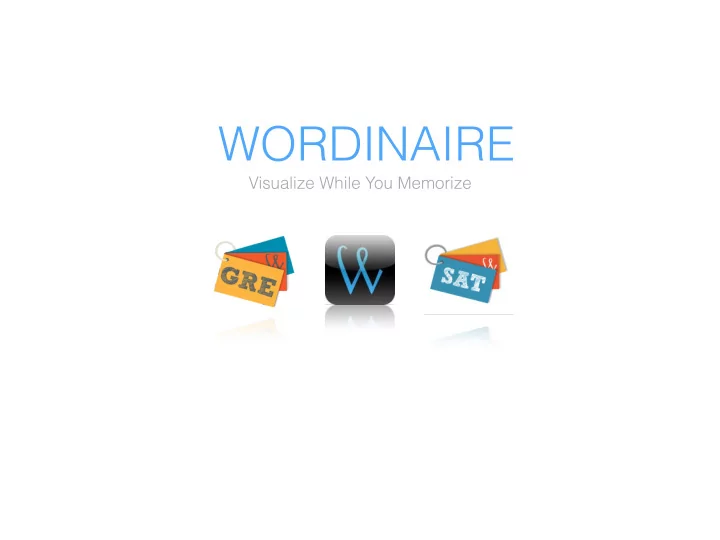

WORDINAIRE Visualize While You Memorize
Multi Modal Learning Our mission at Wordinaire is to make the English language more accessible through multimodal learning • Our vocabulary apps are like digital fl a s h c a r d s w i t h H Q p h o t o s a n d corresponding example sentences so students can learn through contextual association. • Students engaged in learning that incorporates multimodal designs, on average, outperform students who learn using traditional approaches with single modes.* • On average, students using multimodal learning methods experienced a 32% increase in retention skills.* *2013 Cisco Study 2
Prep Material Is Unimodal It’s hard to retain new vocabulary • without visual or contextual association. Flash cards and prep books offer a • banal, unimodal approach to memorizing words. Prep material isn't geared for visual, • foreign, ESL, or disabled learners. 3
Our Multimodal Approach 1,000 essential SAT & GRE vocab words • with pictures and examples sentences Pictures and example sentences offer • contextual association Students using multimodal learning • methods experienced a 32% increase in retention skills (over unimodal learning* *Cisco Multi-Modal Study, 2013 4
Principles Related to Modality Learning 1. Multimedia Principle: Retention is improved through words and pictures rather than through words alone. 2. Modality Principle: Students learn better from visualization and text rather than narration and text. 3. Spatial Contiguity Principle: Students learn better when corresponding words and pictures are presented near each other rather than far from each other on the page or screen. 4. Temporal Contiguity Principle: Students learn better when corresponding words and pictures are presented simultaneously rather than successively. 5. Coherence Principle: Students learn better when relevant words, pictures, and sounds are included rather than excluded. *Columbia University & Metiri Group 5
Visual Reinforcement The two sides of the brain have different attributes and respond to different stimuli. The left side is often described as being better at; • Language • Logic • Critical Thinking The right side is often described as being better at; • Visual imagery • Spatiality • Creativity The left side of the brain is more logical, responding better to textual material, while the right side is more imaginative, responding to images. If the right side is not stimulated, it is harder for students to put ideas into context. Studies have shown that the use of relevant images can increase a student's recollection and comprehension of new material, as well as stimulating discussion and promoting interest.* *University of Utah, Cognitive Study, 2013 6
Ease of Use Swipe up to reveal definition • and example sentence Swipe left/right to reveal more • words Test yourself when ready • Picture is revealed when • answering incorrectly to help with visualization 7
Benefits of Modality for Disabled Learners Research shows that multimodal materials can improve learning for all students, including disabled learners. Several different experiments have shown that when information is presented in contextual and visual form, performance on complex tasks is improved.* Multimodal software is highly beneficial for students with;* 1. Auditory Processing Disorder 2. Dyslexia 3. Language Processing Disorder 4. Non-verbal Learning Disabilities 5. ADHD 6. Memory Processing Disorder 7. Autism Over 100 studies on use of multi-modal learning in building vocabulary found that combining visual, verbal and audible information can lead to enhanced comprehension in disabled learners.* *NCAM.org *WGBH Research Group 8
Benefits of Modality for ESL Learners It’s difficult learning a foreign language without visual aids for contextual association- Proper neurological connections can’t be formed without a reference to draw on. • Pictures along with contextual example sentences help students form a correlation when learning new words. • Pictures are 82% more effective when learning a new language compared standard text alone.* • Picture stimuli have an advantage over word stimuli because they are dually encoded; they generate a verbal and image code, whereas word stimuli only generate a verbal code.* • According to picture superiority effect, new languages are more likely to be remembered experientially if they are presented with pictures rather than just words.* *Columbia University, Visual Cues in Foreign Language, 2012 9
Current Offering SAT & GRE Vocabulary Apps for iPhone 10
Recommend
More recommend